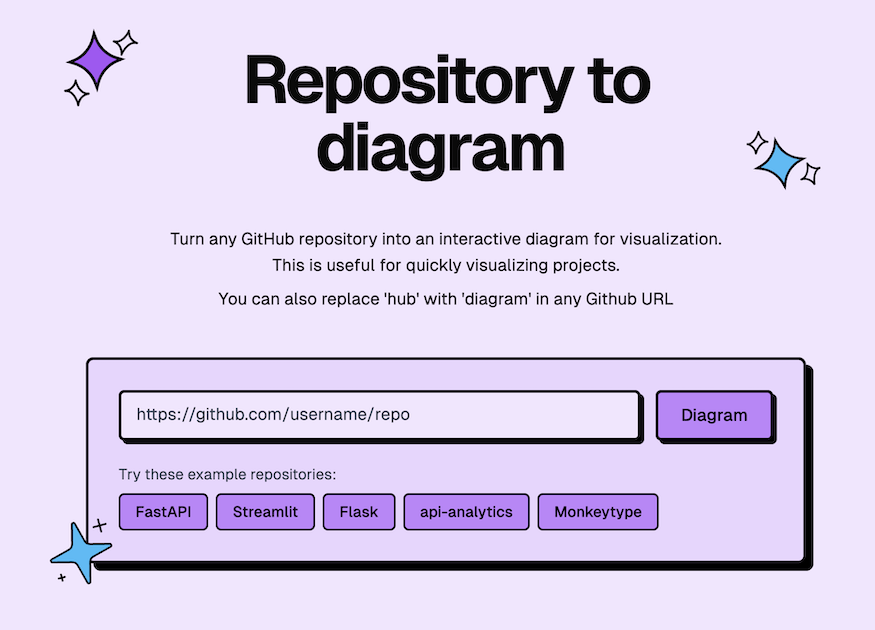Table of Contents
Overview
Ever felt lost navigating a sprawling GitHub repository? Wish there was a simple way to visualize the architecture and dependencies without diving deep into the code? Enter GitDiagram, a free and open-source tool designed to transform any GitHub repo into an interactive, visual map. With a simple URL tweak, you can unlock a whole new perspective on project structure and streamline your understanding of complex codebases. Let’s explore what GitDiagram has to offer.
Key Features
GitDiagram packs a punch with its intuitive features, making codebase exploration a breeze:
- Interactive GitHub Repo Visualization: Transform any GitHub repository into a dynamic diagram, offering a visual representation of its structure.
- Real-time Diagram Rendering: Experience instant diagram generation directly from the repository’s current state, ensuring you’re always working with the latest information.
- File Tree and README Parsing: GitDiagram intelligently analyzes the file tree and README to create a comprehensive and informative diagram.
- Claude 3.5 Sonnet AI Integration: Leverages the power of AI to enhance diagram generation and understanding of the codebase.
- Source File Navigation: Seamlessly navigate from the diagram directly to the source files within the repository.
- Private Repo Support with GitHub Token: Securely visualize private repositories by providing a GitHub token for authorized access.
How It Works
The magic of GitDiagram lies in its simplicity. To visualize a GitHub repository, simply replace “hub” with “diagram” in the repository’s URL. For example, change github.com/user/repo to gitdiagram.com/user/repo. GitDiagram then uses AI to analyze the repository’s file tree and README, generating an interactive diagram that visually represents the project’s architecture and dependencies. You can then navigate through the diagram to explore different parts of the codebase and understand their relationships.
Use Cases
GitDiagram offers a variety of practical applications for developers and teams:
- Codebase Onboarding: Quickly grasp the structure of a new codebase, accelerating the onboarding process for new team members.
- System Architecture Presentation: Effectively communicate the architecture of a system to stakeholders through a clear and interactive visual representation.
- Dependency Mapping: Visualize the dependencies between different components of a project, aiding in understanding the impact of changes.
- Documentation Enhancement: Supplement traditional documentation with interactive diagrams, providing a more engaging and intuitive learning experience.
- Developer Collaboration: Facilitate collaboration among developers by providing a shared visual understanding of the codebase.
Pros & Cons
Like any tool, GitDiagram has its strengths and weaknesses. Let’s break them down:
Advantages
- Free and Open Source: Enjoy the benefits of a powerful visualization tool without any cost or licensing restrictions.
- Simple URL Integration: Easily access GitDiagram’s functionality with a simple URL modification, streamlining the visualization process.
- Supports Private Repos: Securely visualize private repositories by providing a GitHub token for authorized access.
Disadvantages
- Limited to GitHub: Currently, GitDiagram only supports GitHub repositories, limiting its applicability to other version control systems.
- Feature Set Still Growing: While powerful, GitDiagram’s feature set is still evolving, with potential for further enhancements and additions.
How Does It Compare?
While GitDiagram offers a unique approach to codebase visualization, it’s worth considering its alternatives:
- Octotree: Provides a tree view of the repository’s file structure, but lacks the interactive diagramming capabilities of GitDiagram.
- Sourcegraph: Offers deeper code search and analysis features, but is less focused on visual representation and interactive exploration.
- CodeSee: Provides more enterprise-focused features for codebase understanding, but may be less accessible for individual developers or smaller teams.
Final Thoughts
GitDiagram offers a compelling solution for visualizing and understanding GitHub repositories. Its simple URL integration, interactive diagrams, and AI-powered analysis make it a valuable tool for developers of all skill levels. While its feature set is still growing and its GitHub exclusivity might be limiting for some, its free and open-source nature makes it a worthwhile addition to any developer’s toolkit. Give it a try and see how it can transform your understanding of complex codebases!
https://gitdiagram.com